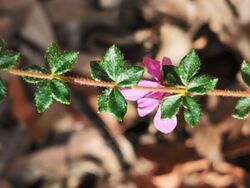Biology:Tetratheca thymifolia
| Tetratheca thymifolia | |
|---|---|

| |
| D'Aguilar National Park: upper surfaces of leaves & flower | |

| |
| discolorous lower sides of leaves & inside of flower | |
| Scientific classification | |
| Kingdom: | Plantae |
| Clade: | Tracheophytes |
| Clade: | Angiosperms |
| Clade: | Eudicots |
| Clade: | Rosids |
| Order: | Oxalidales |
| Family: | Elaeocarpaceae |
| Genus: | Tetratheca |
| Species: | T. thymifolia
|
| Binomial name | |
| Tetratheca thymifolia | |
Tetratheca thymifolia, commonly known as black-eyed Susan or thyme pink-bells, is a small shrub in the family Elaeocarpaceae found in southeastern Australia.[1]
It was first described by English botanist James Edward Smith in 1804. Its species name is derived from the Latin word folium "leaf" and thymus like the plant of that name.[2] The genus name is derived from the Ancient Greek tetra "four", and theke "sac, box" and relates to the four-celled anthers.[2]
Tetratheca thymifolia grows as a tough-stemmed shrub up to a metre (3 ft) high. Flowering occurs mainly from September to November but individual flowers can be seen at any time of year. The 2.5 cm (1 in) diameter flowers have a strong fragrance on hot days.[2]
The species occurs in southeastern Queensland, through New South Wales and into East Gippsland in eastern Victoria, where it is found in heathland or eucalyptus woodland on sandy soils.[2][3]
Introduced to horticulture in 1824 in England, Tetratheca thymifolia has been cultivated to some degree since. Several forms have been selected for horticulture, including T. 'Bicentennial Belle',[2] which originates from a naturally occurring population near Bega, New South Wales. This form reaches 0.7 m tall by up to 0.9 m wide, and is freely suckering. It was registered with the Australian Cultivar Registration Authority in 1985 by Austraflora Nursery in Montrose, Victoria.[4] It flowers all year, with peaks in spring and autumn., and has larger flowers than the species. Overall, Tetratheca thymifolia does best in well-drained acidic soils in a sunny or semi-shaded aspect, and tolerates light frosts. It is grown in container gardens or rockeries.[2]
References
- ↑ "Tetratheca thymifolia". Australian Plant Name Index (APNI), IBIS database. Centre for Plant Biodiversity Research, Australian Government, Canberra. http://www.anbg.gov.au/cgi-bin/apni?TAXON_NAME=Tetratheca+thymifolia. Retrieved 2010-06-14.
- ↑ 2.0 2.1 2.2 2.3 2.4 2.5 Elliot, Rodger W.; Jones, David L.; Blake, Trevor (2010). Encyclopaedia of Australian Plants Suitable for Cultivation: Volume 9 – Sp-Z. Port Melbourne: Lothian Press. pp. 227, 240. ISBN 978-0-7344-0974-4.
- ↑ "Tetratheca thymifolia Sm". PlantNET - New South Wales Flora Online. Royal Botanic Gardens & Domain Trust, Sydney Australia. http://plantnet.rbgsyd.nsw.gov.au/cgi-bin/NSWfl.pl?page=nswfl&lvl=sp&name=Tetratheca~thymifolia. Retrieved 2010-06-14.
- ↑ "Tetratheca 'Bicentennial Belle'". Descriptions of Registered Cultivars. Australian Cultivar Registration Authority. http://www.anbg.gov.au/acra/descriptions/acc374.html. Retrieved 2010-06-14.
External links
- Tetratheca thymifolia : Kew specimen K000591930 from Herbarium Hookerianum
- Tetratheca thymifolia: Occurrence data from Australasian Virtual Herbarium
Wikidata ☰ Q3519186 entry
 |

